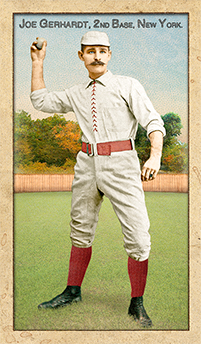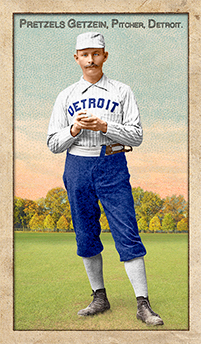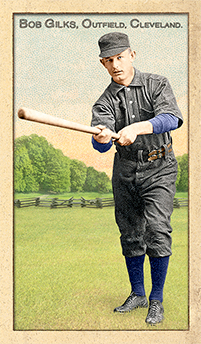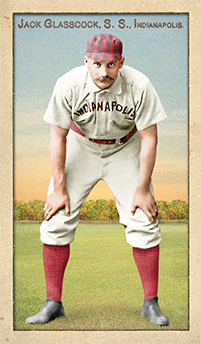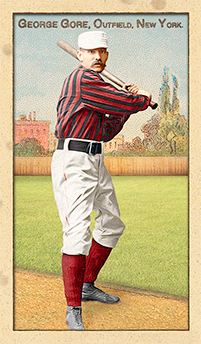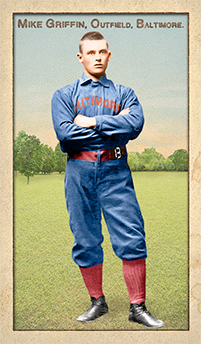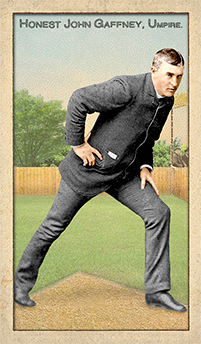
- Series: Beginnings: 1880's
- League: National League
John H. Gaffney (1855-1913) was denied a major league career as a third-baseman by an arm injured throwing a snowball. Baseball may have lost an infielder but gained its first great umpire when, in 1884, Gaffney joined the National League cadre. Renowned for his expert pitch calling, no official presided over more post-season games in the 19th century than “Honest John.” His general baseball expertise led to his being hired to manage the Washington D.C Nationals club in 1886-87. Gaffney pioneered important changes in umpiring practices including using multiple refs, positioning of field umps and defining foul balls. The umpire bore the brunt of fan outrage in a day when violence was all too prevalent on the field. Perhaps succumbing to such pressure, John was felled by the scourge of his era, alcoholism, and left the majors in 1894. Brief failed attempts to revive his NL career did, however, allow him to become one of only two, with Tom Lynch, to officiate twelve seasons in baseball’s first century.
- Dubbed the “King of the Umpires”, John was so admired by players that Connie Mack and Hank O’Day surprised him with a diamond ring in appreciation for his management skills during their ’87 Series
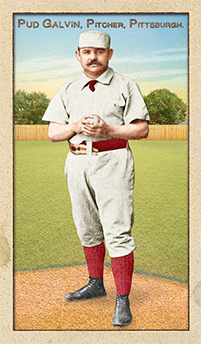
- Series: Beginnings: 1880's
- City: Pittsburgh
- Team: Alleghenys
- League: National League
- Hall: National Baseball Hall of Fame
James Francis Galvin (1856-1902) sported some colorful nicknames: Pud, Gentle Jeems and The Little Steam Engine, indicative of his renown. Pud was baseball’s first 300-game winner. He pitched for six teams over 15 years, and remains the only player to win 20+ games in ten seasons and not win a pennant. Only Cy Young pitched more innings or hurled more complete games, a testimony to the extraordinary demands placed on starters in the 19th century. Perhaps no pitcher of any era accomplished so much by overcoming a distinct physical limitation. In Galvin’s case, it was his small hands which left him unable to completely grip a baseball. He couldn’t throw the curve so he adapted, becoming an expert in “drops, straight balls and the different artifices known to pitchers to deceive the batter” as he told a friend. As his steam engine nickname suggests, Pud just rolled right at the hitter with power and durability yet with amazing finesse, especially in holding runners on base. Buck Ewing was a great admirer and said he wouldn’t have had anyone attempting steals with Galvin on the mound.
- Galvin threw no-hitters in 1880 and ‘84
- Began and ended his long career in St Louis with the NA’s Brown Stockings and NL’s Browns
- Elected to Hall of Fame: 1965
- Galvin's uniform color on this card was changed in April, 2017 from black to red to reflect recent reliable research by Craig Brown & friends at Threads of Our Game. Nine cards had been previously released featuring a black uniform.
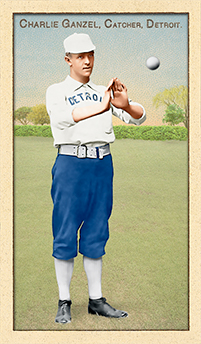
- Series: Beginnings: 1880's
- City: Detroit
- Team: Wolverines
- League: National League
Charles William Ganzel (1862-1914) was reared in Kalamazoo with nine siblings, part of what would be called the “First Family” of Michigan baseball. Charlie had the longest major league career, 14 seasons, with his best coming with the Wolverines and Beaneaters for whom he served nine years behind the plate. Usually a reliable reserve, Ganzel had to step up when longtime teammate Charlie Bennett lost both legs in a train accident. The duo had moved from Detroit to Boston as part of the then highest-cost foursome sold: $30,000. They had split the duties in 1887 when the Wolverines reached their peak, winning the NL flag and defeating the Browns in the post-season. Charlie’s years in Boston were very productive with three more pennants. A lifetime .259 BA testified to his skill offensively and he was always praised for his defense.
- Brother John saw major-league experience as did son Foster who followed 43 years after Dad’s debut, still the longest gap for father/son major-league debuts
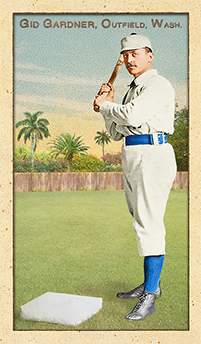
- Series: Beginnings: 1880's
- City: Washington, D.C.
- Team: Nationals
- League: National League
Franklin Washington Gardner (1859-1914) is proof of the power of eulogy. His obit writer in Sporting Life on Aug 22, 1914 said: “…from 1878 until about 1890 [Gardner] was one of the best ball players in the country.” This of one who compiled a lifetime .233 average, was 2-12 during sporadic stints on the mound, and played for 8 clubs in a seven-year tenure in the majors – only once playing consecutive seasons for the same team. He was suspended and fired more often than he changed uniforms. Bill James counts Gid among the 8 men most worthy of the title “Drinking Men” of the 1880s, an era not known for sobriety and decorum. Gardner’s intro to the big leagues came with the Troy Trojans in 1879 after impressing many in New England’s small towns. He made it to age 32 when, upon his father’s death, Gid went home to live with mom and never held a job again. Evidence of how endearing this rogue could be: he mysteriously disappeared from his semi-pro Norwich team in 1890 for weeks mid-season, yet “was cheered by a few hundred fans at the train depot when he returned.”
- His best year was ’83 with the Orioles, batting .273 in 42 games. In September, manager Billy Barnie fined Gid for drunkenness on a road trip to NY

- Series: Beginnings: 1880's
- City: Sioux City
- Team: Corn Huskers
- League: Western Association
C. Frank Genins (1866-1922) had a modest career as a utility fielder for three major league clubs in the 1890s. Frenchy had started out getting paid to play ball with the Omaha Omahogs of the Western League in 1887, en route to a total of 16 years in the minors. He concluded his playing days with the Racine Belles of the Wisconsin-Illinois League in 1909, having also managed in his latter seasons for three teams. Whether in the farm leagues or the bigs, Genins was consistently mediocre at the plate. His MLB average was .226. His most plate appearances came with Sioux City in 1894 where Frenchy had his best output, batting .374 with seven home runs. He exceeded .300 a couple other times so he had some decent seasons along the way. Genins’ stints in the majors were with his hometown Browns in ‘92 (one game?), the Reds for a longer trial that year, the Pirates in ‘95 and with Cleveland’s Blues in 1901. Frenchy had a respectable season in Pittsburgh, hitting .250, playing seven positions, and was the only outfielder to spell the team’s beloved trio of Mike Smith, Patsy Donovan and Jake Stenzel.
- Frenchy has five known poses in the Old Judge series and all five come in a curious variant: Genins is oftentimes misspelled as "Genius." The editors of the Photographic Baseball Cards of Goodwin & Co. conclude that the misspelling is an error, but I am inclined to disagree. Considering the amount of intentional humor interspersed throughout the Old Judge canon, the fact that the misspelling is prevalent across Frenchy's entries, and perhaps most tellingly that one must only flip an "n" upside down in Genins to turn Frenchy into a "Genius" - and I am inclined to believe that this misspelling was indeed purposeful at the hands of the Goodwin pranksters.
- Series: Beginnings: 1880's
- City: New York
- Team: Giants
- League: National League
William M. George (1865-1916) was a left-handed pitcher & outfielder for two major league teams over 3 years in the late 1880s. He debuted as a pitcher for the NY Giants in ’87. During his two seasons on the mound, George went 5-10 with a 4.51 ERA. His mediocre performance led to him being released by the Giants in June of ‘89. He had not gotten into a game that year in NY. The native of Bellaire, OH tried out with the American Association’s Columbus Solons in July of 1889. They picked him up as an outfielder. Bill got into five games that summer, getting 4 hits and 3 RBI in 17 at-bats & was released in August, ending his major league experience.
- Bill’s record in ’88 was 2-1 with a 1.34 ERA. But, with Tim Keefe winning 35 with an 1.74 ERA & Mickey Welch winning 26 with a 1.93 ERA, the competition was stiff on the pennant winner
- Series: Beginnings: 1880's
- City: New York
- Team: Giants
- League: National League
John Joseph Gerhardt (1855-1922) played for 11 teams over his 15-year career, primarily at second base. He averaged only .227 at the plate but led the league at times in key fielding categories. He played for the biggest teams of his day: the Giants, Mutuals, and Reds and also for the more obscure: the Washington Blue Legs, the Baltimore Canaries, the Louisville Eclipse and the Brooklyn Gladiators.
- Gerhardt was named manager of two of his teams: Louisville in 1883 and St. Louis in 1890
- A 1922 NY writer compared him favorably to the best: “None had anything on Move Em Up Joe Gerhardt”
- Series: Beginnings: 1880's
- City: Detroit
- Team: Wolverines
- League: National League
Charles H. Getzein (1864-1932) mastered the “pretzel curve,” thrown with a skipping delivery and a sharp overhand swing. The pastry analogy may have been hyperbole, but he was able to baffle hitters for nine major league seasons for five teams. Charlie came into his own with the Detroit Wolverines and was stellar in 1886-87 winning 59 games plus hurling six complete games in the ’87 “Series.”
- Game 6 of that tourney was witnessed by 10,000 at the Polo Grounds. Getzein no-hit St Louis for 8 innings, shutting them out en route to a Detroit championship
- Teamed with catcher Charlie Ganzel, a duo sports writers dubbed the “Pretzel Battery”
- Career record: 145-139 including 277 complete games with an ERA of 3.46
- Series: Beginnings: 1880's
- City: Cleveland
- Team: Blues (AA)
- League: American Association
Robert James Gilks (1864-1944) was an outfielder and pitcher for the Cleveland Blues, Spiders and Baltimore Orioles from 1887-1893. In the OF, Gilks was credited with piloting the strategy of trapping fly balls in order to get force-outs. He was said to have been the first OF to get an unassisted double-play.
- Another first: two bases-loaded doubles in the same inning, Aug. 5, 1890
- Played on the famed Orioles squad with McGraw, Keeler, Kelley, and Wilbert Robinson in ’92-3

- Series: Beginnings: 1880's
- City: Washington, D.C.
- Team: Nationals
- League: National League
Bernard Gilligan (1856-1934) may serve as the textbook example of “good field, no hit.” As a hitter, he ranks among the all-time worst, 1 of 6 catchers to occupy the “top” ten list. But “Little Barney” was superb behind the plate & drew accolades from his first outings until his last games in semi-pro ball around Boston past the turn of the century. And no matter how weak his offense, no catcher ever had the year Barney did in 1884. He was Old Hoss Radbourn’s personal catcher & caught every game of the greatest season by a major league hurler. Depending on who is counting, Radbourn won 59 or 60 games and the pennant that magical season. With “hands half beaten to a pulp by catching 81 regular-season games,” the diminutive backstop humbly accepted a personalized Springfield watch (worth over $4000 today) commemorating his role in Radbourn’s year for the ages. The presentation came during the post-season tourney which Radbourn and his Providence Grays swept in three. When the Grays were being dissolved, Boston passed on Gillligan, distrusting his arm strength. The Senators were delighted to add him to their expansion-club roster in ’86.
- It took a rookie Connie Mack to dislodge Barney from his starting role
- As if spurred by his pitcher’s greatness, Gilligan had his best year at the plate in ’84
- Gilligan’s uniform color on this card was changed in May, 2017 from black to blue to reflect recent reliable research by Craig Brown & friends at Threads of Our Game. Six cards had been previously released featuring a black uniform.
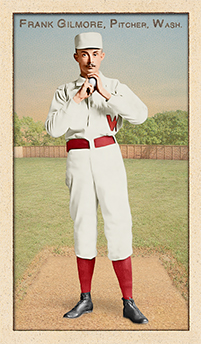
- Series: Beginnings: 1880's
- City: Washington, D.C.
- Team: Nationals
- League: National League
Franklin T. Gilmore (1864-1929) was nicknamed “Shadow” and cast a giant one with Washington when he formed the “Grasshopper Battery” (per John Thorn) or the “bones battery” as dubbed by early journalists, with catcher Connie Mack. The two made a striking pair: angular stringbeans of sinew and bone. Gilmore debuted in D.C. in 1886. There is dispute as to whether the Nationals wanted Gilmore or Mack more, but they came as a tandem and would be such during Frank’s all-too-brief sojourn in the majors. The battery-mates from Hartford’s Dark Blues’ ‘86 team were not only similar in build and stature, they were very close as roommates. Years later, Mr. McGillicuddy would reminisce about spending all night rubbing Gilmore’s arm with liniment in what proved a vain effort to prolong the young phenom’s career. Shadow reached a pinnacle on September 28 that rookie year when he fanned 16 St Louis Maroons, equaling the year’s best strikeout performance. Perhaps foreshadowing the young hurler’s future, the Nationals lost the contest 5-2, giving Gilmore poor support.
- The slender pitcher’s ML record proved slim as well: three seasons with Washington, 12 wins against 33 losses, a 4.26 ERA with 212 Ks in 405 innings
- On a side note, Bill James ranked Gilmore the worst professional baseball player of the 19th century
- Series: Beginnings: 1880's
- City: Indianapolis
- Team: Hoosiers (NL)
- League: National League
John Wesley Glasscock (1857-1947) was the premier shortstop of the 19th century. Some of his records (fielding % & assists) stood until Ozzie Smith a century later. No slouch at the plate, Glasscock averaged .290 and led the NL in ’90 for the Giants.
- In ’89, discovered the young Amos Rusie and signed him for the Hoosiers’ final season
- Went 6 for 6 on 9/27/90 to secure the batting title over Billy Hamilton
- One of the toughest to strikeout of his era, averaging one every 33 ABs
- Was selected as SABR's Overlooked 19th Century Baseball Legend for 2016
- Series: Beginnings: 1880's
- City: Philadelphia
- Team: Quakers
- League: National League
William J. Gleason (1866-1933). A pitcher and 2nd baseman over 22 seasons with 7 different teams, Gleason went on to manage the Chicago White Sox from 1919 to 1923 and is perhaps best known for being the manager during the 1919 Black Sox Scandal. As a pitcher, Kid won 138 games. As a hitter, Kid compiled 1,946 hits & a .261 career BA.
- One of 29 players to play in 4 different decades
- Won 38 games in 1890
- Coached under Connie Mack for 8 seasons
- Gleason’s uniform color on this card was changed in April, 2017 from black to blue/red to reflect recent reliable research by Craig Brown & friends at Threads of Our Game. Nine cards had been previously released featuring a black uniform.
- Series: Beginnings: 1880's
- City: New York
- Team: Giants
- League: National League
“Piano Legs” (1857-1933). An outfielder for 4 teams over 14 major league seasons, Gore was an excellent hitter who played on 7 pennant winning teams and in 4 World Series. His alcoholism oftentimes put him at odds with teammates, fans, and managers.
- All-time leader in OF errors: 368
- Stole 7 bases in 1 game; a record
- Had 5 extra-base hits in 1 game: a record he achieved by hitting 3 doubles & 2 triples against Old Hoss Radbourn
- Won NL batting title: 1880
- Series: Beginnings: 1880's
- City: Baltimore
- Team: Orioles
- League: American Association
Michael Joseph Griffin (1865-1908) was an accomplished center fielder for the AA’s Orioles, the Players’ League’s Athletics and the NL’s Bridegrooms over 12 seasons. He batted over .300 six times, scored 100+ runs ten times and stole 473 bases. On 4/16/87 he became the 1st ML player to hit a HR in his first plate appearance. Ended his career as player-mgr for Brooklyn.
- Caught up in the Baltimore/Brooklyn merger in ’98, won a salary judgment of $2,300 and retired
- Managed local Utica breweries until his death from pneumonia at 43
- Griffin’s uniform color on this card was changed in May, 2017 from black to blue/red to reflect recent reliable research by Craig Brown & friends at Threads of Our Game. Nine cards had been previously released featuring a black uniform.
- Series: Beginnings: 1880's
- City: Milwaukee
- Team: Creams
- League: Western Association
- Hall: National Baseball Hall of Fame
Clark Calvin Griffith (1869-1955) was a successful pitcher for over 20 years but had only just begun his baseball career. AL founder Ban Johnson prevailed on Griffith to take the helm of the NY entry into the new league in 1903. That began a tenure as manager and owner that lasted until Griffith’s death in 1955. With a showman’s touch and a veteran player’s savvy, Griffith turned around the D.C. franchise.
- Only one in history to be a player, manager and owner for over 20 years in each role
- Counted eight U.S. presidents as friends during his long tenure as owner of the Senators
- Elected to Hall of Fame: 1946
- Griffith's uniform color in this card was changed from blue to red in March, 2017 to reflect recent reliable research conducted by Craig Brown and friends at Threads of Our Game. Three cards had been previously released featuring a blue uniform.
- Series: Beginnings: 1880's
- City: Chicago
- Team: White Stockings
- League: National League
Addison Courtney Gumbert (1868-1925) was a pitcher for six teams over nine years, 1888-96. He debuted with the Chicago White Stockings and played for both the Brooklyn Bridegrooms and Philadelphia Phillies in ’96. Gumbert gained a spot in Cub history as the starting pitcher in 1892 for the Chicago Colts. (The Cub franchise, with the Atlanta Braves, are the only surviving “charter members” of the NL.)
- Established a career 123-102 record, with a 4.27 ERA
- Best year was with Boston’s Players’ League entry in 1890, winning 23 for “King” Kelly’s team

- Series: Beginnings: 1880's
- City: Boston
- Team: Beaneaters
- League: National League
Thomas Francis Gunning (1862-1931) looks like a mediocre ball player on the record. His six years in MLB show a weak hitting catcher whose defense was shaky. The stats belie a “sober, honest, reliable and energetic” player who was a credit to his sport. Popular at every level in which he played, Tom was as serious about his studies as about baseball, which is saying something. Even when he was completing his medical degree at the University of Pennsylvania, and with a bad arm, Gunning played for his school team and for Hartford. His major league tenure began with the Beaneaters in 1884 where he played three seasons before moving on to the two Philadelphia clubs, the Quakers and Athletics. His lifetime .205 average and .887 fielding % don’t begin to express his value to his teams or the esteem of his managers and colleagues. Frequently chosen to fill in as an umpire, Gunning was known for his objectivity, sometimes to the dismay of his teammates during a rowdy and partisan era. He turned down overtures from St. Louis in ’87 to remain in Philadelphia and med school.
- Gunning eschewed protective gear & frequently paid the price
- Was assigned as a rookie to the Massachusetts State Association – a “reserve” league concocted by the Beaneaters to safeguard their youngsters from the Union Association’s depredations
- As a young MD in Fall River, MA, had a role in the inquests into the 1892 Lizzie Borden axe murders case
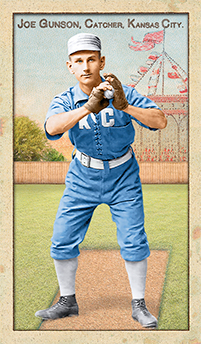
- Series: Beginnings: 1880's
- City: Kansas City
- Team: Blues (WA)
- League: Western Association
Joseph Brook Gunson (1863-1942) was a pioneer catcher in baseball’s early days. Three years before his death, Gunson donated his original mitt to the new Hall of Fame. During his life and since, historians have been as split over who deserves the honor of inventing the catcher’s glove as were the fingers of Gunson and his fellow backstop on the Western League KC Blues. Those torn hands prompted Gunson to contrive some protection. Doc Bushong or Harry Decker may have beaten Joe to the draw, but there can be no argument that this stalwart receiver was a key contributor to the game he loved. Gunson debuted with the lowly Washington club of the upstart Union Association in 1884, then knocked around the minors until catching on with the Browns, Spiders, Orioles and Cowboys during a four-year ML stint.
- Gunson’s stats are unimpressive: a .211 BA, with little power. Yet, like so many early players, he made his mark on the fledgling sport with grit and creativity which laid a foundation for all who were to follow
- The Sporting Life compared Gunson’s hands with their “knots and gnarls” to famed Chicagoan Sylvester “Silver” Flint’s “battered paws.” Such was the catcher’s lot in the 19th century….






